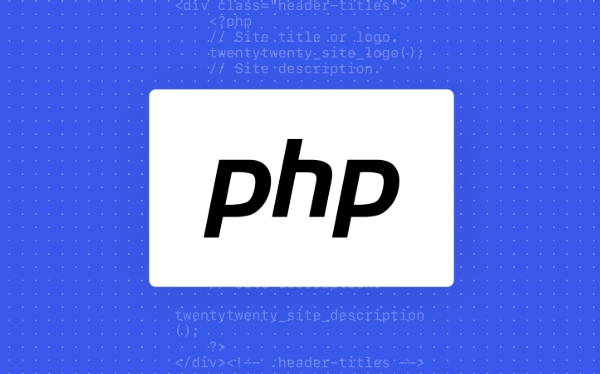A PHP session stores user-specific data on the server, providing security and persistence across pages. 1. When session_start() is called, PHP generates a unique session ID. 2. This ID is stored in a client-side cookie and used to retrieve server-stored session data. 3. Session variables are accessed via the $_SESSION array for tracking login status, preferences, or cart contents. 4. Ending a session requires unsetting variables with $_SESSION = [] and calling session_destroy(). 5. Common issues include incorrect session start placement, inconsistent domains, timeout settings, and storing sensitive data in sessions.

A PHP session is a way to store information (in variables) across multiple pages for a specific user. Unlike cookies, which store data on the client side, sessions store data on the server, making them more secure and reliable for handling sensitive or temporary user-specific information.

How PHP Sessions Work
When a session starts, PHP creates a unique identifier (called a session ID) for that user. This ID is stored in a cookie on the user’s browser and used to associate the user with their session data on the server.
Here’s what happens behind the scenes:

- You call
session_start()at the beginning of your script. - PHP checks if there's a session ID in the request. If not, it creates a new one.
- The session data is stored in a file (or other storage mechanism configured on the server).
- Each time the user makes a request, PHP retrieves the session data based on the session ID and makes it available via the
$_SESSIONsuperglobal.
This allows you to keep track of things like login status, shopping cart contents, or user preferences as they navigate through your site.
Using Session Variables
Once a session has started, you can store and retrieve data using the $_SESSION array.

For example:
session_start(); $_SESSION['username'] = 'john_doe';
Then on another page:
session_start(); echo 'Welcome back, ' . $_SESSION['username'];
You can also update or remove session data:
- Update:
$_SESSION['username'] = 'jane_doe'; - Remove one item:
unset($_SESSION['username']); - Remove all session data:
$_SESSION = [];
Keep in mind that until you call session_start(), the $_SESSION array won’t be accessible.
Ending or Destroying a Session
Ending a session involves two steps: unsetting the session variables and destroying the session itself.
To completely log a user out or clear their session:
- Start the session with
session_start(). - Unset all session variables with
$_SESSION = [];. - Destroy the session with
session_destroy();.
Also, if you want to make sure the session cookie is deleted:
if (ini_get("session.use_cookies")) {
$params = session_get_cookie_params();
setcookie(session_name(), '', time() - 42000,
$params["path"], $params["domain"],
$params["secure"], $params["httponly"]
);
}This ensures the browser forgets the session ID, so the user won’t be recognized next time unless they start a new session.
Common Issues and Tips
Sometimes sessions don’t behave as expected. Here are a few common pitfalls:
-
Session not starting: Make sure
session_start()is called before any output is sent to the browser — including whitespace or HTML. - Lost session variables: Avoid using inconsistent domain names (like switching between www and non-www), as this may prevent the session cookie from being sent.
-
Session timeout: By default, sessions expire after a period of inactivity (usually around 24 minutes). You can adjust this by changing settings in your
php.inifile or managing expiration manually.
Also, never store sensitive data like passwords in session variables. While sessions are more secure than cookies, they still reside on the server and can be accessed if compromised.
That's how PHP sessions work in practice — nothing too complicated, but easy to mess up if you're not careful with the details.
The above is the detailed content of What is a PHP session?. For more information, please follow other related articles on the PHP Chinese website!

Hot AI Tools

Undress AI Tool
Undress images for free

Undresser.AI Undress
AI-powered app for creating realistic nude photos

AI Clothes Remover
Online AI tool for removing clothes from photos.

Clothoff.io
AI clothes remover

Video Face Swap
Swap faces in any video effortlessly with our completely free AI face swap tool!

Hot Article

Hot Tools

Notepad++7.3.1
Easy-to-use and free code editor

SublimeText3 Chinese version
Chinese version, very easy to use

Zend Studio 13.0.1
Powerful PHP integrated development environment

Dreamweaver CS6
Visual web development tools

SublimeText3 Mac version
God-level code editing software (SublimeText3)

Hot Topics
 How to use sessions for user authentication in the Slim framework
Jul 28, 2023 pm 05:57 PM
How to use sessions for user authentication in the Slim framework
Jul 28, 2023 pm 05:57 PM
Method of using sessions (Sessions) for user authentication in the Slim framework In web applications, user authentication is an important function, which ensures that only authorized users can access restricted resources. Sessions are a commonly used authentication method that ensures that users remain authenticated throughout the session by storing user identity and status information. The Slim framework provides convenient tools and middleware to handle sessions and user authentication. Below we will introduce how to use sessions in the Slim framework
 How to use sessions to implement user login and logout in the Slim framework
Jul 28, 2023 pm 11:21 PM
How to use sessions to implement user login and logout in the Slim framework
Jul 28, 2023 pm 11:21 PM
Introduction to the method of using sessions to implement user login and logout in the Slim framework: Sessions are a technology commonly used in web applications. It can be used to store and manage user-related data, such as the user's login status. wait. As a lightweight PHP framework, the Slim framework provides a simple API to handle sessions. This article will introduce how to use sessions in the Slim framework to implement user login and logout functions. To install the Slim framework first, we need to
 Start a session using the PHP function 'session_start'
Jul 24, 2023 pm 09:40 PM
Start a session using the PHP function 'session_start'
Jul 24, 2023 pm 09:40 PM
PHP is a powerful server-side scripting language that is widely used in website development. Session management is an integral part of website development, which allows us to transfer and store user data between different pages. In PHP, we can start a session using the function "session_start". Before starting, we need to make sure that the session function of the PHP server is turned on. PHP's session function relies on a session storage directory on the server, which is the operating system's temporary directory by default. I
 How to create and manage sessions using PHP built-in functions?
Apr 22, 2024 am 11:18 AM
How to create and manage sessions using PHP built-in functions?
Apr 22, 2024 am 11:18 AM
The steps to manage sessions in PHP are as follows: Create a session: Use the session_start() function. Set session variables: Use the $_SESSION array to store data. Access session variables: Use the $_SESSION array to retrieve data from the session. Destroy the session: Use the session_destroy() function to end the session. Practical case: Login page: Verify login information and set session variables upon successful login. Home page: Check session variables and redirect to login page if user is not logged in. Exit page: Destroy the session and redirect to the login page.
 Detailed explanation of how PHP sessions are destroyed after 30 minutes (with code examples)
Nov 14, 2022 pm 04:34 PM
Detailed explanation of how PHP sessions are destroyed after 30 minutes (with code examples)
Nov 14, 2022 pm 04:34 PM
This article will introduce you to the issue of how to specify the time to destroy the PHP session. Here is a detailed introduction to how to destroy the session through the session_destroy() function. I hope it will be helpful to friends in need~
 How to create and use sessions using PHP
Apr 30, 2024 pm 05:09 PM
How to create and use sessions using PHP
Apr 30, 2024 pm 05:09 PM
Sessions are used in PHP to store and retrieve user data across requests. After a session is created, data can be stored and retrieved using the $_SESSION array. It is suitable for shopping cart management, user experience customization and login status maintenance. Create session code: session_start(); store data: $_SESSION['key']='value'; retrieve data: $value=$_SESSION['key']; destroy session: session_destroy().
 PHP session management tips: How to destroy session data using the session_unset function
Jul 29, 2023 pm 01:21 PM
PHP session management tips: How to destroy session data using the session_unset function
Jul 29, 2023 pm 01:21 PM
PHP session management tips: How to use the session_unset function to destroy session data In PHP, session management is a very important task. Sessions are a way of passing data across multiple pages. Through sessions, data can be shared and passed between multiple pages. However, sometimes we need to destroy session data to ensure security and privacy. PHP provides the session_unset function for destroying session data. When we call the session_unset function, it clears the current
 Database session sharing design and optimization: tips in PHP programming
Jun 22, 2023 pm 12:20 PM
Database session sharing design and optimization: tips in PHP programming
Jun 22, 2023 pm 12:20 PM
Database Session Sharing Design and Optimization: Tips in PHP Programming When programming PHP, many developers will use databases to store and manage data. During this process, a common question is how to optimize database sessions to improve program performance. In this article, we will explore the design and optimization techniques of database session sharing, and how to improve the performance of your program through these techniques. What is a database session? When writing PHP programs, many developers need to use database access operations (usually using PDO, mysq






